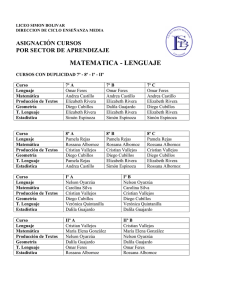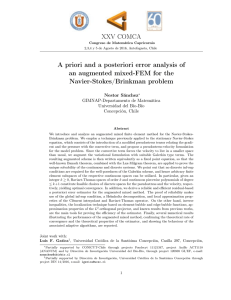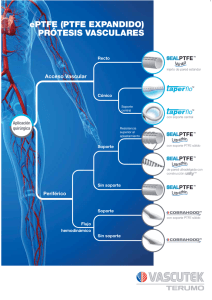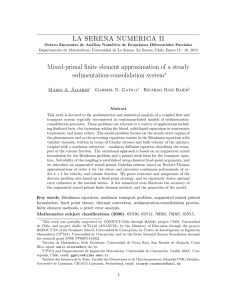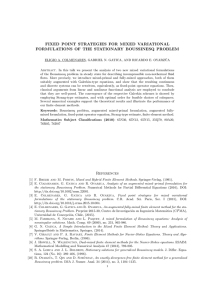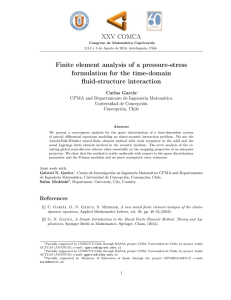A posteriori error analysis of an augmented fully
Anuncio
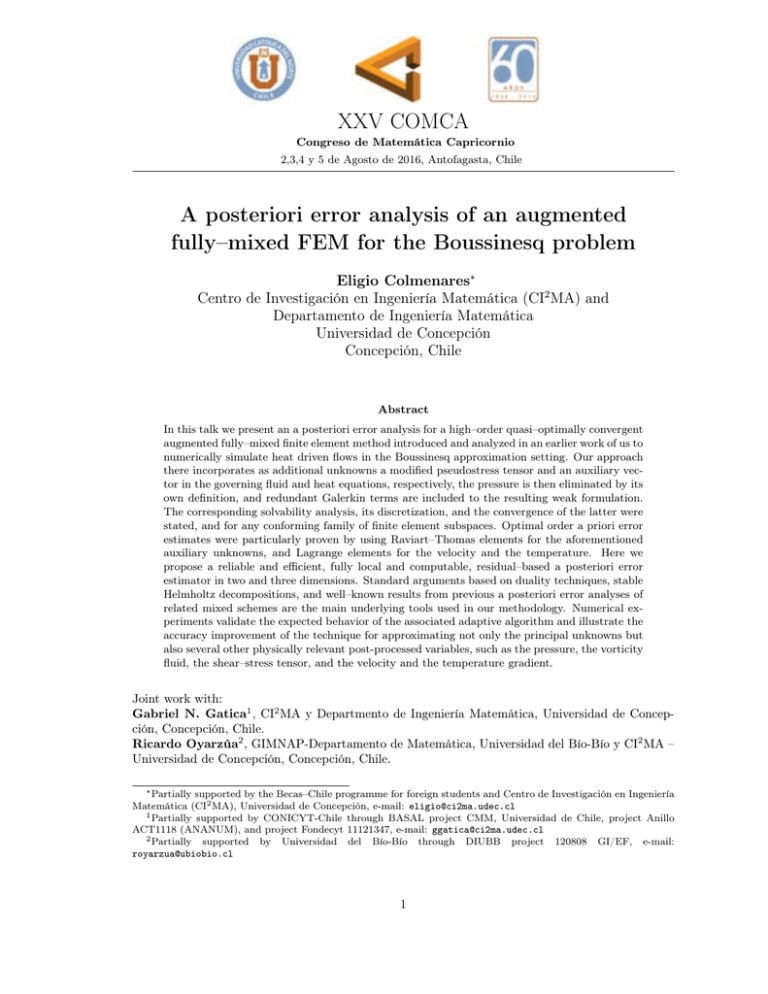
XXV COMCA Congreso de Matemática Capricornio 2,3,4 y 5 de Agosto de 2016, Antofagasta, Chile A posteriori error analysis of an augmented fully–mixed FEM for the Boussinesq problem Eligio Colmenares∗ Centro de Investigación en Ingeniería Matemática (CI2 MA) and Departamento de Ingeniería Matemática Universidad de Concepción Concepción, Chile Abstract In this talk we present an a posteriori error analysis for a high–order quasi–optimally convergent augmented fully–mixed finite element method introduced and analyzed in an earlier work of us to numerically simulate heat driven flows in the Boussinesq approximation setting. Our approach there incorporates as additional unknowns a modified pseudostress tensor and an auxiliary vector in the governing fluid and heat equations, respectively, the pressure is then eliminated by its own definition, and redundant Galerkin terms are included to the resulting weak formulation. The corresponding solvability analysis, its discretization, and the convergence of the latter were stated, and for any conforming family of finite element subspaces. Optimal order a priori error estimates were particularly proven by using Raviart–Thomas elements for the aforementioned auxiliary unknowns, and Lagrange elements for the velocity and the temperature. Here we propose a reliable and efficient, fully local and computable, residual–based a posteriori error estimator in two and three dimensions. Standard arguments based on duality techniques, stable Helmholtz decompositions, and well–known results from previous a posteriori error analyses of related mixed schemes are the main underlying tools used in our methodology. Numerical experiments validate the expected behavior of the associated adaptive algorithm and illustrate the accuracy improvement of the technique for approximating not only the principal unknowns but also several other physically relevant post-processed variables, such as the pressure, the vorticity fluid, the shear–stress tensor, and the velocity and the temperature gradient. Joint work with: Gabriel N. Gatica1 , CI2 MA y Departmento de Ingeniería Matemática, Universidad de Concepción, Concepción, Chile. Ricardo Oyarzúa2 , GIMNAP-Departamento de Matemática, Universidad del Bío-Bío y CI2 MA – Universidad de Concepción, Concepción, Chile. ∗ Partially supported by the Becas–Chile programme for foreign students and Centro de Investigación en Ingeniería Matemática (CI2 MA), Universidad de Concepción, e-mail: [email protected] 1 Partially supported by CONICYT-Chile through BASAL project CMM, Universidad de Chile, project Anillo ACT1118 (ANANUM), and project Fondecyt 11121347, e-mail: [email protected] 2 Partially supported by Universidad del Bío-Bío through DIUBB project 120808 GI/EF, e-mail: [email protected] 1 References [1] M. Álvarez, G. N. Gatica, R. Ruíz–Baier, A posteriori error analysis for a viscous flow–transport problem, ESSAIM: Mathematical Modelling and Numerical Analysis, DOI: http://dx.doi.org/10.1051/m2an/2016007. [2] E. Colmenares, G. N. Gatica, R. Oyarzúa, An augmented fully-mixed finite element method for the stationary Boussinesq problem, Calcolo, to appear. DOI: 10.1007/s10092-0160182-3. [3] E. Colmenares, G. N. Gatica, R. Oyarzúa, Analysis of an augmented mixed–primal formulation for the stationary Boussinesq Problem, Numerical Methods for Partial Differential Equations, vol. 32, 2, pp. 445-478, (2016). [4] E. Colmenares, G. N. Gatica, R. Oyarzúa, Fixed point strategies for mixed variational formulations of the stationary Boussinesq problem, Comptes Rendus - Mathematique, vol. 354, 1, pp. 57-62, (2016). [5] E. Colmenares, M. Neilan, Dual–mixed formulations for the stationary Boussinesq problem, Preprint 2016–07, Centro de Investigación en Ingeniería Matemática (CI2 MA), Universidad de Concepción, Chile, (2016). [6] C. Dominguez, G. N. Gatica, S. Meddahi, A posteriori error analysis of a fully-mixed finite element method for a two-dimensional fluid-solid interaction problem, Journal of Computational Mathematics, vol. 33, 6, pp. 606-641, (2015). [7] G. N. Gatica, G. Hsiao, S. Meddahi, A residual–based a posteriori error estimator for a two-dimensional fluid-solid interaction problem, Numerische Mathematik, vol. 114, 1, pp. 63-106, (2009). 2
